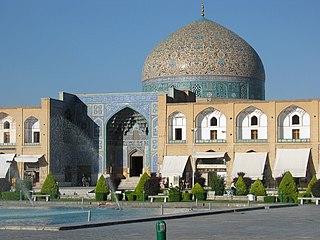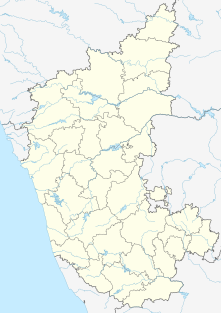
Kermanshah Province is one of the 31 provinces of Iran. The province was known from 1969 to 1986 as Kermanshahan and from 1986 to 1995 as Bakhtaran. According to a 2014 segmentation by the Ministry of Interior it is center of Region 4, with the region's central secretariat located at the province's capital city, Kermanshah. A majority of people in Kermanshah Province are Shia, and there are Sunni and Yarsani minority groups.

Iranian architecture or Persian architecture is the architecture of Iran and parts of the rest of West Asia, the Caucasus and Central Asia. Its history dates back to at least 5,000 BC with characteristic examples distributed over a vast area from Turkey and Iraq to Uzbekistan and Tajikistan, and from the Caucasus to Zanzibar. Persian buildings vary from peasant huts to tea houses, and garden pavilions to "some of the most majestic structures the world has ever seen". In addition to historic gates, palaces, and mosques, the rapid growth of cities such as the capital Tehran has brought about a wave of demolition and new construction.

Khorramabadpronunciation (help·info) is a city and the capital of Lorestan Province, Iran. At the time of the 2016 census, its population was 373,416 persons. Khorramabad is situated on the Zagros Mountains. Khorramabad Airport is 3 km south of the city proper.

Borujerd is a city and the capital of Borujerd County, Lorestan Province in western Iran. At the 2016 census, its population was 234,997 persons. Among the existing modern cities in Iran, Borujerd is one of the oldest reported at least since the 9th century. In Sassanid Empire, Borujerd was a small town and region neighboring Nahavand. Gaining more attention during Great Seljuq Empire in the 9th and 10th centuries, Borujerd stood as an industrial, commercial and strategic city in Zagros Mountains until the 20th century. In its golden ages, Borujerd was selected as the state capital of Lorestan and Khuzestan region during Qajar dynasty in the 18th and 19th centuries.

Sheikh Lotfollah Mosque is one of the masterpieces of Iranian architecture that was built during the Safavid Empire, standing on the eastern side of Naqsh-i Jahan Square, Esfahan, Iran. Construction of the mosque started in 1603 and was finished in 1619. It was built by the chief architect Mohammadreza Isfahani, during the reign of Shah Abbas I of Persia. On the advice of Arthur Upham Pope, Reza Shah Pahlavi had the mosque rebuilt and repaired in the 1920.

Damghan is the capital of Damghan County, Semnan Province, Iran. At the 2006 census, its population was 57,331, in 15,849 families. It is situated 342 km (213 mi) east of Tehran on the high-road to Mashad, at an elevation of 1,250 m (4,101 ft). It is one of the oldest cities on the Iranian plateau, stretching back 7,000 years, and boasts many sites of historic interest. The oldest of these is Tappeh Hessar, lying to the southeast of the city, which holds the ruins of a castle dating from the Sasanian Empire.

Kashmar is a city and the capital of Kashmar County, in Razavi Khorasan Province, Iran. Kashmar is located near the river Shesh Taraz in the western part of the province, and south of the province's capital Mashhad, in Iran, from east to Bardaskan, west to Torbat-e Heydarieh, north to Nishapur, south to Gonabad. Until two centuries ago, this city was named Torshiz (ترشیز). At the 2006 census, its population was 81,527, in 21,947 families.

Manvi is a town in the Raichur district of the Indian state of Karnataka. It is the municipal headquarters of the Manvi taluk.

The Jāmeh Mosque of Borujerd is a congregational mosque (Jāmeh) in Borujerd, in the province of Loristan, western Iran. The mosque is the oldest mosque in the Zagros area and western Iran. It ranks as No. 228 in the Inventory of National Artefacts of Iran.

Azerbaijan Museum is the major archaeological and historical museum in Tabriz, in the northwest part of Iran. It was established on April 1958. The museum consists of three major halls, a side yard, office rooms and a library. It mostly contains objects discovered from excavations in Iranian Azerbaijan, also some artworks and sculptures of artists. Its library contains more than 2500 books, both handwritten and printed, about history, archaeology, art and Iranian culture. Apart from National Museum of Iran in Tehran, Azerbaijan Museum has the largest collection belonging to different periods of Iran's history.

Miandoab County is a county in West Azerbaijan Province in Iran. The capital of the county is Miandoab. This city is located in the south of Urmia Lake and between the two rivers Zarrineh river and Simineh river.

The Great Mosque of Herat or "Jami Masjid of Herat", is a mosque in the city of Herat, in the Herat Province of north-western Afghanistan. It was built by the Ghurids, under the rule of the Sultan Ghiyath al-Din Muhammad Ghori, who laid its foundation in 1200 CE, and later extended by several rulers as Herat changed rulers down the centuries from the Timurids to the Safavids, Mughals and then the Uzbeks, all of whom supported the mosque. Though many of the glazed tiles have been replaced during subsequent periods, the Friday Mosque in Herat was given its present form during the closing years of the fifteenth century.

The Ganjali Khan Complex is a Safavid-era building complex, located in the old center of city of Kerman, Iran. The complex is composed of a school, a square, a caravanserai, a bathhouse (hammam), an Ab Anbar, a mint, a mosque and a bazaar.

The Tarikhaneh Temple, also called the Tarikhaneh Mosque, is a Sassanid-era monument located on the southern limit of the present day city of Damghan, Iran.
Seljuk architecture comprises the building traditions used by the Seljuk dynasty, when it ruled most of the Middle East and Anatolia during the 11th to 13th centuries. After the 11th century, the Seljuks of Rum emerged from the Great Seljuk Empire developing their own architecture, though they were influenced and inspired by the Armenian, Byzantine and Persian architectural traditions.

Darreh Shahr is a city, and seat of Darreh Shahr County, located in the south-eastern part of Ilam Province, in the northern foothills of Kabir Kuh ranges. According to the 2016 census there are 21,900 residents, making it the second-largest city in the province.

Delgosha Garden is one of the historical gardens in Shiraz, Iran near Tomb of Sa’di and it belongs to the pre-Islamic era of the Sassanian Empire.

Seifollah Kambakhshfard was an Iranian archaeologist, who specialized in archaeology and Ancient History of Iran.

Deir-e Gachin Caravansarai is one of the greatest caravansarais of Iran which is located in the center of Kavir National Park. Its unique qualities is the reason it is called “Mother of Iranian Caravansarais”. It is located in the Central District of Qom County, 80 kilometers north-east of Qom and 35 kilometers south-west of Varamin. This monument was registered in Iran's National Heritage List on September 23, 2003. The structure of this caravanserai belongs to Sasanian era, and restorations took place in Seljuk, Safavid and Qajar eras. Its current form belongs to Safavid era. This caravanserai is situated on the ancient rout from Ray to Isfahan.

The Izad Khast Castle is located in Izadkhast in the Fars Province, central Iran. The castle was built during the Sassanid Empire and functioned as fortified walled city on the ancient Silk Road that ran through central Iran. It is the second largest adobe building in the world after Arg-e Bam.

































